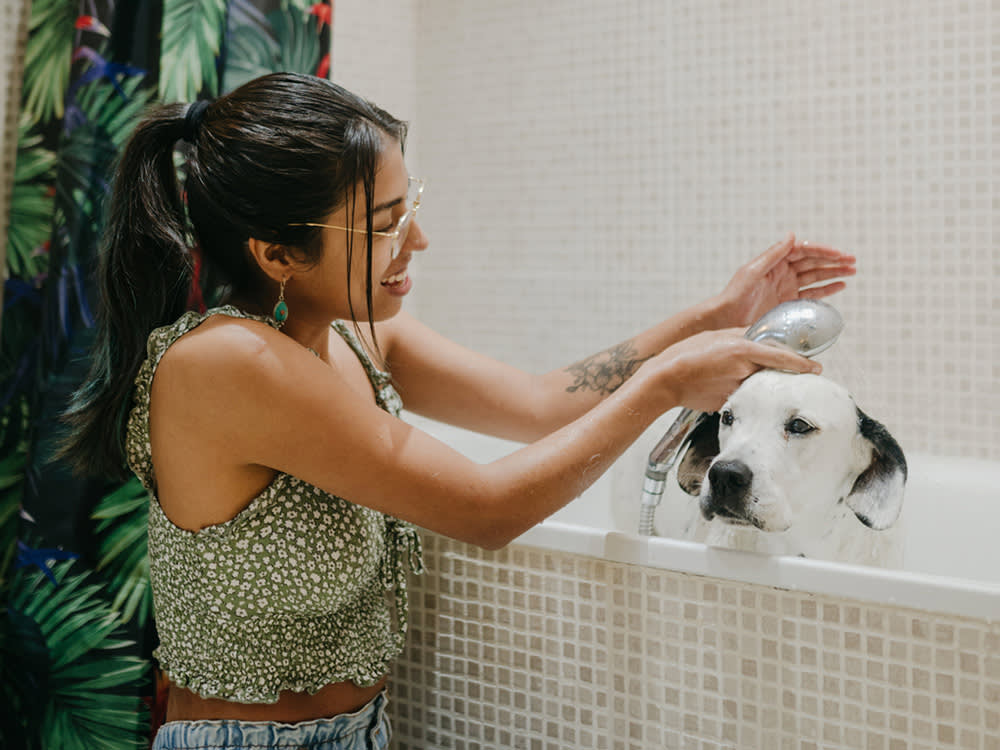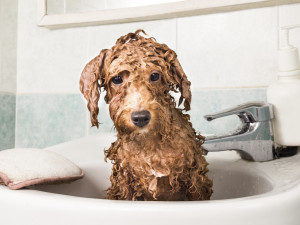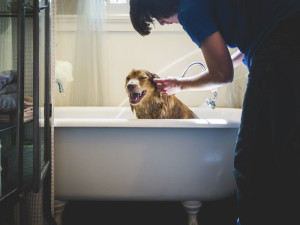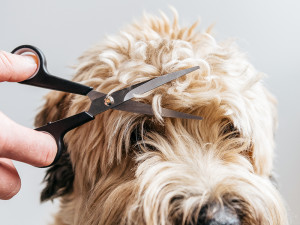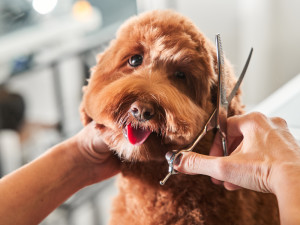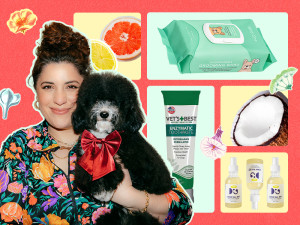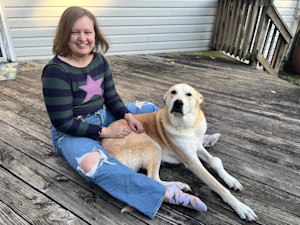How to Groom Your Dog at Home: the Complete Guide
Spa days can happen at home.
A good haircut can make you feel like a new person. Regular grooming can keep your pup looking cute and feeling comfortable, too. Even better: Maintaining your dog’s coat, claws, and skin can prevent potential health issues and help ensure that your pup avoids extra trips to the vet.
Some pet parents choose to outsource all this maintenance to a professional groomer, but if your budget doesn’t allow for this extra expense or you just can’t find a qualified groomer in your area, you may want to take on your dog’s grooming at home. Get the lowdown on trimming your dog’s fur, cleaning their ears, brushing their teeth, and more tips on dog grooming at home.
What is considered dog grooming?
When you think of dog grooming in homes or from a professional groomer, you may think of the fancy haircuts worn by show dogs. But some dogs, like short-haired breeds, don’t even need trims, while others require regular cuts to keep their fur from growing matted. All dogs benefit from regular maintenance, such as bathing, brushing, nail trims, teeth cleaning, and ear and eye cleaning. These seemingly small tasks can add up to help keep your dog healthy and happy.
Why is routine grooming important for dogs?
Not every dog needs frequent bathing, but it’s important to know how often to groom your dog, based on their coat type. Not only does regular grooming keep your dog’s fur clean, but it can also help to prevent serious health issuesopens in new tab. Grooming a dog at home is also a good opportunity for you to take a closer look at your dog’s coat, teeth, nails, eyes, and ears for any issues that could turn into potential health concerns.
How much do you spend on your pet per year?
What supplies do you need to groom your dog at home?
The right tools can help you become an at-home dog grooming expert. Always choose supplies that are specifically made for dogs, and if you’re not sure which products to buy, ask your veterinarian or a professional groomer for the best dog grooming tools for home use. Be sure to research what tools work best for your dog’s coat length and texture. For example, short-haired dog breeds do best with bristle brushes.
Here are a few dog-grooming products to add to your shopping list:
A rubber-bristled brush, steel comb, or de-shedding tool
Dog-safe nail clippers or a Dremel nail grinder
A styptic pencil or powder for any accidental bleeding from nail trims
A dog toothbrush and toothpaste
Cotton balls or reusable cloth squares
Round-tip shears or a small clipper with guide combs
Dog shampoo and conditioner
For drying your dog after a bath, you can use a microfiber tool or a hair dryer on its lowest setting.
How to trim your dog’s fur at home
If you decide to give your dog a trim at home, you should always do so carefully and slowly. Look up some informational videos on YouTube by qualified groomers for tips on how to get started — and avoid giving your dog a bad haircut.
Step 1: Get your dog clean.
Never trim your dog’s fur unless it’s as clean as possible. Before grooming a dog’s hair at home, brush their fur to remove any mats or debris and then give them a thorough bath. Make sure your dog’s fur is completely dry before you start trimming.
Step 2: Trim the delicate areas.
Use blunt-ended shears (the ones with a round tip) or small clippers to carefully trim the hair covering your dog’s eyes and genital area, as well as the hair between their paws. Some dogs may need a lot of trimming in these areas, while others may need little to none.
Step 3: Perform an overall trim (if desired).
If your dog’s fur is getting a little long, you can lightly trim the rest of their coat. Be sure to keep the blades far away from your dog’s skin.
What if my dog won’t sit still?
Unless you’ve been handling your dog’s grooming at your house since they were a puppy, they’ll probably be uncomfortable with the process. Start by getting your dog accustomed to the presence and noise of shears or clippers, and make sure to offer plenty of praise and treats. It may take a few months of this gradual exposure before your dog is comfortable enough to be properly trimmed, but hopefully you can one day treat grooming like a spa day!
What precautions should I take when trimming my dog’s hair?
Go slowly and cut sparingly. Make small trims instead of big cuts. You can always go back and trim a little more, but if you cut off too much, you can only wait for it to grow back. And never get too close to your dog’s skin with the blades — a small twitch could result in injury.
What should I avoid doing when trimming my dog’s hair at home?
Instead of just diving in, watch instructional videos online about dog grooming for beginners at home. Have a plan for how you’ll keep your dog still while trimming their fur, and make sure not to cut a dirty or matted coat. Always brush and bathe your dog before you attempt any trim.
How to bathe your dog
Speaking of bathing, most dogs can benefit from regular baths. Just make sure not to bathe your dog too frequently — doing so can remove natural oils from their skin and dry out their coat. Ask your vet or a professional groomer how often you should bathe your dog based on their breed and coat type.
Step 1: Brush them thoroughly.
Water just makes mats worse, so make sure to brush your dog before putting them in the tub. Brushing can also help remove some of the dirt and debris your dog may gather outside, which can help keep you from having to clean your tub post-bathtime.
Step 2: Lather up that shampoo.
Never use human shampoo or bath soap on a dog. Only use a shampoo that’s designed and formulated for dogs and make sure to keep it out of their eyes and ears. The best way to do this is to wet your dog with warm water and apply shampoo from the neck back, lathering and scrubbing thoroughly.
Step 3: Rinse the shampoo off.
Once you’ve shampooed your dog from the neck down, use clean, warm water to rinse, taking care to cover their eyes and ears to avoid any soap seeping in.
Step 4: Clean the face.
With a cotton ball or damp cloth, clean your dog’s eyes, wiping away any discharge (that gunky stuff that gathers in the corners). Clean their ears too, gently removing any outer ear wax.
Step 5: Dry them gently.
Once your dog is all clean, it’s time to dry them off. You can use a microfiber towel to gently dry their fur or turn a hair dryer on its lowest setting, keeping it away from your dog’s skin to prevent burns. Your dog will also gladly help by shaking the water off their body (and onto the bathroom walls, but that’s a different problem).
How to brush your dog’s fur
Brushing your dog’s coat a few times a week can help prevent mats and keep their fur clean. If you have the time, consider brushing your dog every day. Grooming your dog’s hair at home can also be a bonding experience for both you and your dog, just like petting, and help draw you closer.
Brush gently but thoroughly.
Instead of surface-level grooming, brush your dog’s fur all the way down to the skin. The gentle massaging movement of the brush can help loosen and remove debris and dandruff, as well as stimulate their circulation.
Check for problem spots.
Brushing your dog is a good opportunity to look for any areas of concern, including:
Mats, which tend to form behind a dog’s ears and under their legs
Burrs, leaves, and other plant debris from outside
Cuts or scrapes on your dog’s skin
How to trim your dog’s nails
Regularly trimming your dog’s nails can prevent serious damage and pain to their paws, as well as help avoid cracked and broken nails. Most dogs require a nail trim every three to four weeks, or before their nails touch the ground.
When trimming your dog’s nails, make small, careful slices, trimming only the part of the nail that turns down. Avoid cutting the quick, which is the blood vessel in the nail and will bleed if cut. In a white nail, the quick is the pink part you can see. It’s harder to glimpse in black nails, so be extra careful trimming and keep a styptic pencil or powder on hand to stop any accidental bleeding.
If you want to avoid the stress of frequent nail trims — for you and your dog — consider investing in a scratchpad, which is an easy way to trim dog nails without breaking out the clippers.
How to clean your dog’s ears
It’s a good idea to clean your dog’s ears at least once a month — more if they tend to be prone to ear infections and similar issues. For example, dogs with floppy ears are more likely to have ear problems.
Using a cotton ball or damp cloth soaked in mineral oil, clean the outer part of your dog’s ear. Your dog may need the hair inside their ear plucked as well, to help air circulation and prevent the growth of bacteria. Ask your vet how often you should clean your dog’s ears and whether you need to remove the hair inside.
How to brush your dog’s teeth
Your dog’s teeth can benefit from brushing as often as possible — up to twice a day, if you can, just like you. Teeth cleaning prevents gum disease, which can lead to more severe health issues in the heart, liver, and kidneys. Plus, ensuring your dog’s teeth are clean and healthy can eliminate the need for costly cleanings at the vet.
To clean your dog’s teeth, use a soft toothbrush and a toothpaste specifically made for dogs. Never use human toothpaste, which can be toxic to your dog. You can also give your dog dental treats and chews to help remove plaque and contribute to healthy teeth.
Additional dog grooming tips
Maintaining your dog’s health requires time and patience, but it can save you on vet bills and ensure your beloved companion sticks around for years to come. Follow these additional tips on dog grooming at home:
Make sure to use the right brush for your dog’s fur. Ask your vet or a professional groomer which brush is appropriate.
Reduce grooming time by cleaning your dog’s coat with a damp towel when they come in from outside.
Regularly check your dog’s paw pads for any injuries, cracks, or dryness.
Only use vet-approved dog grooming and hygiene products.
Give plenty of treats, praise, and snuggles to help your dog opens in new tabfeel safe and comfortable throughout the grooming process.
FAQs (People also ask):
How often should I groom my dog?
The frequency of grooming depends on your dog’s coat type and length. Dogs with short, smooth, or wiry coats only need brushing once a week, while dogs with long, silky, or curly coats benefit from daily brushing. All long-haired dogs need a full grooming (that means trimming, bath, nail trimming, and eye and ear cleaning) every four to eight weeks. Short-haired dogs just need monthly baths and cleanings.
Can I groom my dog without professional training?
You don’t need professional training to groom your dog at home, but it certainly helps to watch instructional videos online and to ask your vet or a groomer any questions you may have.
